Detect objects in images
The Azure AI Custom Vision service enables you to create computer vision models that are trained on your own images. You can use it to train image classification and object detection models; which you can then publish and consume from applications.
In this exercise, you will use the Custom Vision service to train an object detection model that can detect and locate three classes of fruit (apple, banana, and orange) in an image.
While this exercise is based on the Azure Custom Vision Python SDK, you can develop vision applications using multiple language-specific SDKs; including:
- Azure Custom Vision for JavaScript (training)
- Azure Custom Vision for JavaScript (prediction)
- Azure Custom Vision for Microsoft .NET (training)
- Azure Custom Vision for Microsoft .NET (prediction)
- Azure Custom Vision for Java (training)
- Azure Custom Vision for Java (prediction)
This exercise takes approximately 45 minutes.
Create Custom Vision resources
Before you can train a model, you will need Azure resources for training and prediction. You can create Custom Vision resources for each of these tasks, or you can create a single resource and use it for both. In this exercise, you’ll create Custom Vision resources for training and prediction.
- Open the Azure portal at
https://portal.azure.com, and sign in using your Azure credentials. Close any welcome messages or tips that are displayed. - Select Create a resource.
- In the search bar, search for
Custom Vision, select Custom Vision, and create the resource with the following settings:- Create options: Both
- Subscription: Your Azure subscription
- Resource group: Create or select a resource group
- Region: Choose any available region
- Name: A valid name for your Custom Vision resource
- Training pricing tier: F0
- Prediction pricing tier: F0
-
Create the resource and wait for deployment to complete, and then view the deployment details. Note that two Custom Vision resources are provisioned; one for training, and another for prediction.
Note: Each resource has its own endpoint and keys, which are used to manage access from your code. To train an image classification model, your code must use the training resource (with its endpoint and key); and to use the trained model to predict image classes, your code must use the prediction resource (with its endpoint and key).
- When the resources have been deployed, go to the resource group to view them. You should see two custom vision resources, one with the suffix -Prediction.
Create a Custom Vision project in the Custom Vision portal
To train an object detection model, you need to create a Custom Vision project based on your training resource. To do this, you’ll use the Custom Vision portal.
- Open a new browser tab (keeping the Azure portal tab open - you’ll return to it later).
- In the new browser tab, open the Custom Vision portal at
https://customvision.ai. If prompted, sign in using your Azure credentials and agree to the terms of service. - Create a new project with the following settings:
- Name:
Detect Fruit - Description:
Object detection for fruit. - Resource: Your Custom Vision resource
- Project Types: Object Detection
- Domains: General
- Name:
- Wait for the project to be created and opened in the browser.
Upload and tag images
Now that you have an object detection project, you can upload and tag images to train a model.
Upload and tag images in the Custom Vision portal
The Custom Vision portal includes visual tools that you can use to upload images and tag regions within them that contain multiple types of object.
- In a new browser tab, download the training images from
https://github.com/MicrosoftLearning/mslearn-ai-vision/raw/main/Labfiles/object-detection/training-images.zipand extract the zip folder to view its contents. This folder contains images of fruit. - In the Custom Vision portal, in your object detection project, select Add images and upload all of the images in the extracted folder.
- After the images have been uploaded, select the first one to open it.
-
Hold the mouse over any object in the image until an automatically detected region is displayed like the image below. Then select the object, and if necessary resize the region to surround it.
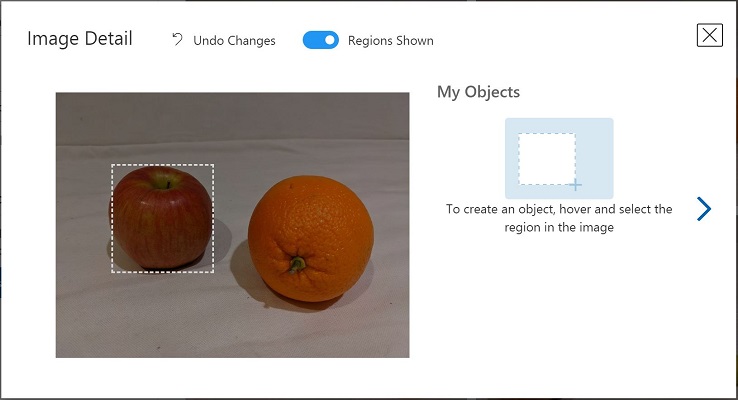
Alternatively, you can simply drag around the object to create a region.
-
When the region surrounds the object, add a new tag with the appropriate object type (apple, banana, or orange) as shown here:
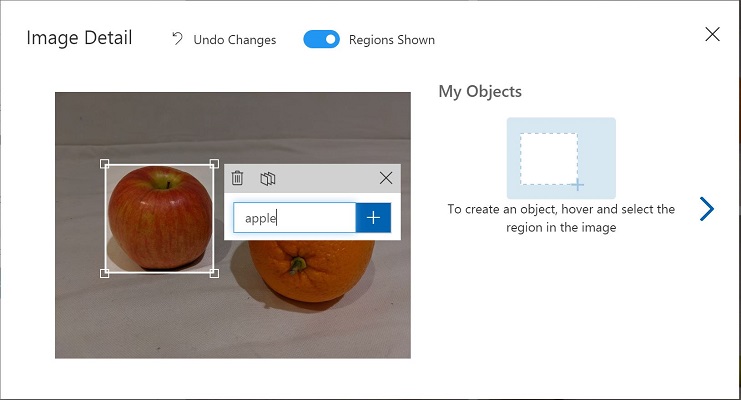
-
Select and tag each other object in the image, resizing the regions and adding new tags as required.
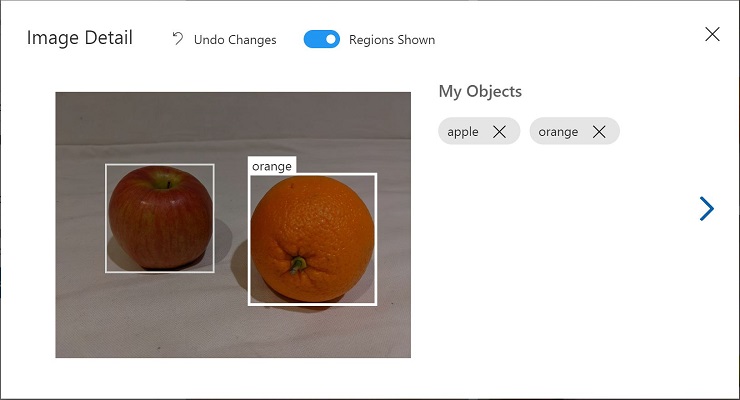
-
Use the > link on the right to go to the next image, and tag its objects. Then just keep working through the entire image collection, tagging each apple, banana, and orange.
- When you have finished tagging the last image, close the Image Detail editor. On the Training Images page, under Tags, select Tagged to see all of your tagged images:
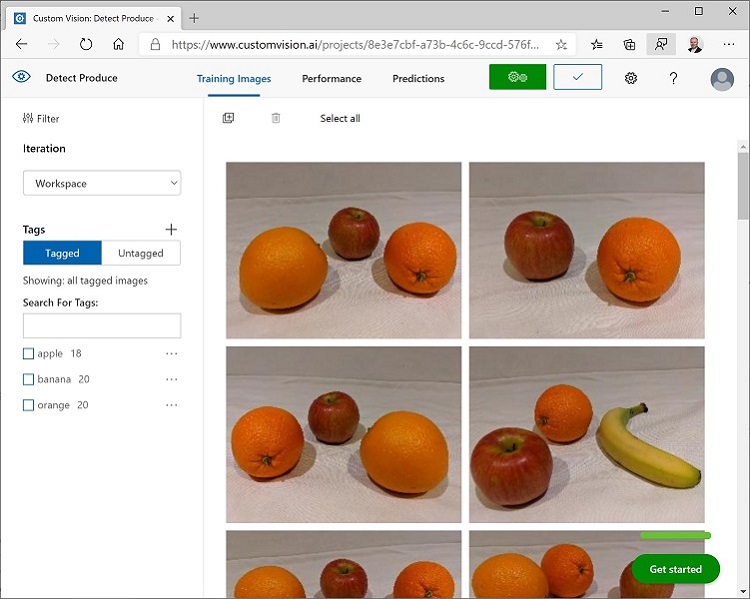
Use the Custom Vision SDK to upload images
You can use the UI in the Custom Vision portal to tag your images, but many AI development teams use other tools that generate files containing information about tags and object regions in images. In scenarios like this, you can use the Custom Vision training API to upload tagged images to the project.
- Click the settings (⚙) icon at the top right of the Training Images page in the Custom Vision portal to view the project settings.
- Under General (on the left), note the Project Id that uniquely identifies this project.
- On the right, under Resources note that the Key and Endpoint are shown. These are the details for the training resource (you can also obtain this information by viewing the resource in the Azure portal).
- Return to the browser tab containing the Azure portal (keeping the Custom Vision portal tab open - you’ll return to it later).
-
In the Azure portal, use the [>_] button to the right of the search bar at the top of the page to create a new Cloud Shell in the Azure portal, selecting a PowerShell environment with no storage in your subscription.
The cloud shell provides a command-line interface in a pane at the bottom of the Azure portal.
Note: If you have previously created a cloud shell that uses a Bash environment, switch it to PowerShell.
Note: If the portal asks you to select a storage to persist your files, choose No storage account required, select the subscription you are using and press Apply.
-
In the cloud shell toolbar, in the Settings menu, select Go to Classic version (this is required to use the code editor).
Ensure you've switched to the classic version of the cloud shell before continuing.
-
Resize the cloud shell pane so you can see more of it.
Tip” You can resize the pane by dragging the top border. You can also use the minimize and maximize buttons to switch between the cloud shell and the main portal interface.
-
In the cloud shell pane, enter the following commands to clone the GitHub repo containing the code files for this exercise (type the command, or copy it to the clipboard and then right-click in the command line and paste as plain text):
rm -r mslearn-ai-vision -f git clone https://github.com/MicrosoftLearning/mslearn-ai-visionTip: As you paste commands into the cloudshell, the ouput may take up a large amount of the screen buffer. You can clear the screen by entering the
clscommand to make it easier to focus on each task. -
After the repo has been cloned, use the following command to navigate to the application code files:
cd mslearn-ai-vision/Labfiles/object-detection/python/train-detector ls -a -lThe folder contains application configuration and code files for your app. It also contains a tagged-images.json file which contains bounding box coordinates for objects in multiple images, and an /images subfolder, which contains the images.
-
Install the Azure AI Custom Vision SDK package for training and any other required packages by running the following commands:
python -m venv labenv ./labenv/bin/Activate.ps1 pip install -r requirements.txt azure-cognitiveservices-vision-customvision -
Enter the following command to edit the configuration file for your app:
code .envThe file is opened in a code editor.
- In the code file, update the configuration values it contains to reflect the Endpoint and an authentication Key for your Custom Vision training resource, and the Project ID for the custom vision project you created previously.
- After you’ve replaced the placeholders, within the code editor, use the CTRL+S command to save your changes and then use the CTRL+Q command to close the code editor while keeping the cloud shell command line open.
-
In the cloud shell command line, enter the following command to open the tagged-images.json file to see the tagging information for the image files in the /images subfolder:
code tagged-images.jsonJSON defines a list of images, each containing one or more tagged regions. Each tagged region includes a tag name, and the top and left coordinates and width and height dimensions of the bounding box containing the tagged object.
Note: The coordinates and dimensions in this file indicate relative points on the image. For example, a height value of 0.7 indicates a box that is 70% of the height of the image. Some tagging tools generate other formats of file in which the coordinate and dimension values represent pixels, inches, or other units of measurements.
-
Close the JSON file without saving any changes (CTRL_Q).
-
In the cloud shell command line, enter the following command to open the code file for the client application:
code add-tagged-images.py - Note the following details in the code file:
- The namespaces for the Azure AI Custom Vision SDK are imported.
- The Main function retrieves the configuration settings, and uses the key and endpoint to create an authenticated CustomVisionTrainingClient, which is then used with the project ID to create a Project reference to your project.
- The Upload_Images function extracts the tagged region information from the JSON file and uses it to create a batch of images with regions, which it then uploads to the project.
-
Close the code editor (CTRL+Q) and enter the following command to run the program:
python add-tagged-images.py - Wait for the program to end.
- Switch back to the browser tab containing the Custom Vision portal (keeping the Azure portal cloud shell tab open), and view the Training Images page for your project (refreshing the browser if necessary).
- Verify that some new tagged images have been added to the project.
Train and test a model
Now that you’ve tagged the images in your project, you’re ready to train a model.
- In the Custom Vision project, click Train (⚙⚙) to train an object detection model using the tagged images. Select the Quick Training option.
-
Wait for training to complete (it might take ten minutes or so).
Tip: The Azure cloud shell has a 20-minute inactivity timeout, after which the session is abandoned. While you wait for training to finish, occassionally return to the cloud shell and enter a colland like
lsto keep the session active. - In the Custom Vision portal, when training has finished, review the Precision, Recall, and mAP performance metrics - these measure the prediction accuracy of the object detection model, and should all be high.
- At the top right of the page, click Quick Test, and then in the Image URL box, type
https://aka.ms/test-fruitand click the quick test image (➔) button. -
View the prediction that is generated.
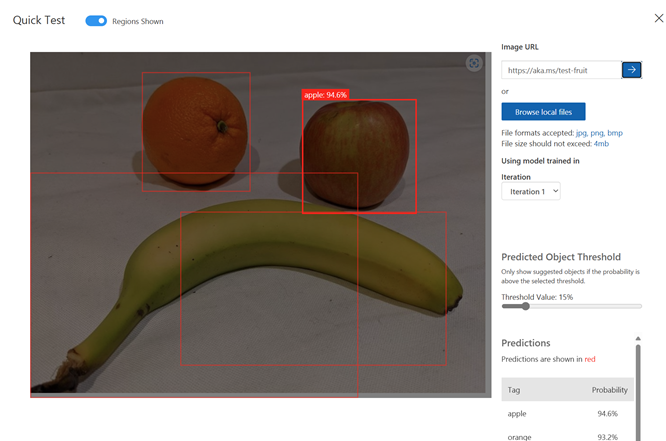
- Close the Quick Test window.
Use the object detector in a client application
Now you’re ready to publish your trained model and use it in a client application.
Publish the object detection model
- In the Custom Vision portal, on the Performance page, click 🗸 Publish to publish the trained model with the following settings:
- Model name:
fruit-detector - Prediction Resource: The prediction resource you created previously which ends with “-Prediction” (not the training resource).
- Model name:
- At the top left of the Project Settings page, click the Projects Gallery (👁) icon to return to the Custom Vision portal home page, where your project is now listed.
- On the Custom Vision portal home page, at the top right, click the settings (⚙) icon to view the settings for your Custom Vision service. Then, under Resources, find your prediction resource which ends with “-Prediction” (not the training resource) to determine its Key and Endpoint values (you can also obtain this information by viewing the resource in the Azure portal).
Use the image classifier from a client application
Now that you’ve published the image classification model, you can use it from a client application. Once again, you can choose to use C# or Python.
- Return to the browser tab containing the Azure portal and the cloud shell pane.
-
In cloud shell, run the following commands to switch to the folder for you client application and view the files it contains:
cd ../test-detector ls -a -lThe folder contains application configuration and code files for your app. It also contains the following produce.jpg image file, which you’ll use to test your model.

-
Install the Azure AI Custom Vision SDK package for prediction and any other required packages by running the following commands:
python -m venv labenv ./labenv/bin/Activate.ps1 pip install -r requirements.txt azure-cognitiveservices-vision-customvision -
Enter the following command to edit the configuration file for your app:
code .envThe file is opened in a code editor.
-
Update the configuration values to reflect the Endpoint and Key for your Custom Vision prediction resource, the Project ID for the object detection project, and the name of your published model (which should be fruit-detector). Save your changes (CTRL+S) and close the code editor (CTRL+Q).
-
In the cloud shell command line, enter the following command to open the code file for the client application:
code test-detector.py - Review the code, noting the following details:
- The namespaces for the Azure AI Custom Vision SDK are imported.
- The Main function retrieves the configuration settings, and uses the key and endpoint to create an authenticated CustomVisionPredictionClient.
- The prediction client object is used to get object detection predictions for the produce.jpg image, specifying the project ID and model name in the request. The predicted tagged regions are then drawn on the image, and the result is saved as output.jpg.
-
Close the code editor and enter the following command to run the program:
python test-detector.py - Review the program output, which lists each object detected in the image.
-
Note that an image file named output.jpg is generated. Use the (Azure cloud shell-specific) download command to download it:
download output.jpgThe download command creates a popup link at the bottom right of your browser, which you can select to download and open the file. The image should look simlar to this:
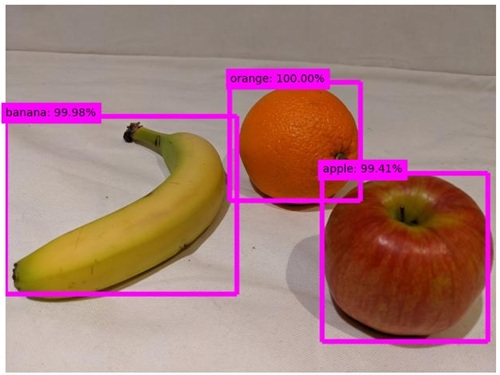
Clean up resources
If you’re not using the Azure resources created in this lab for other training modules, you can delete them to avoid incurring further charges.
-
Open the Azure portal at
https://portal.azure.com, and in the top search bar, search for the resources you created in this lab. -
On the resource page, select Delete and follow the instructions to delete the resource. Alternatively, you can delete the entire resource group to clean up all resources at the same time.
More information
For more information about object detection with the Custom Vision service, see the Custom Vision documentation.